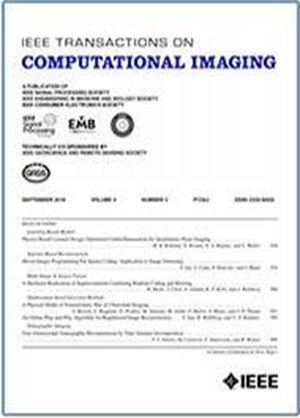An Efficient Algorithm for Spatial-Spectral Partial Volume Compartment Mapping With Applications to Multicomponent Diffusion and Relaxation MRI
IF 4.8
2区 计算机科学
Q2 ENGINEERING, ELECTRICAL & ELECTRONIC
引用次数: 0
Abstract
We introduce a new algorithm to solve a regularized spatial-spectral image estimation problem. Our approach is based on the linearized alternating directions method of multipliers (LADMM), which is a variation of the popular ADMM algorithm. Although LADMM has existed for some time, it has not been very widely used in the computational imaging literature. This is in part because there are many possible ways of mapping LADMM to a specific optimization problem, and it is nontrivial to find a computationally efficient implementation out of the many competing alternatives. We believe that our proposed implementation represents the first application of LADMM to the type of optimization problem considered in this work (involving a linear-mixture forward model, spatial regularization, and nonnegativity constraints). We evaluate our algorithm in a variety of multiparametric MRI partial volume mapping scenarios (diffusion-relaxation, relaxation-relaxation, relaxometry, and fingerprinting), where we consistently observe substantial (一种有效的空间-频谱部分体室映射算法及其在多分量扩散和弛豫MRI中的应用
提出了一种新的正则化空间光谱图像估计算法。我们的方法是基于乘法器的线性化交替方向法(LADMM),这是一种流行的ADMM算法的变体。虽然LADMM已经存在了一段时间,但它在计算成像文献中并没有得到非常广泛的应用。这在一定程度上是因为有许多将LADMM映射到特定优化问题的可能方法,并且从许多相互竞争的替代方案中找到计算效率高的实现并非易事。我们认为,我们提出的实现代表了LADMM在本工作中考虑的优化问题类型(涉及线性混合正演模型,空间正则化和非负性约束)中的首次应用。我们在各种多参数MRI部分体积映射场景(扩散-松弛,松弛-松弛,松弛测量和指纹)中评估了我们的算法,在这些场景中,我们一致观察到实质性的($\sim 3 \,\times$ - 50 ×)速度改进。我们希望这能减少使用空间正则化部分体积隔室映射方法的障碍。此外,我们观察到的相当大的改进也表明将LADMM考虑到更广泛的计算成像问题的潜在价值。
本文章由计算机程序翻译,如有差异,请以英文原文为准。
求助全文
约1分钟内获得全文
求助全文
来源期刊

IEEE Transactions on Computational Imaging
Mathematics-Computational Mathematics
CiteScore
8.20
自引率
7.40%
发文量
59
期刊介绍:
The IEEE Transactions on Computational Imaging will publish articles where computation plays an integral role in the image formation process. Papers will cover all areas of computational imaging ranging from fundamental theoretical methods to the latest innovative computational imaging system designs. Topics of interest will include advanced algorithms and mathematical techniques, model-based data inversion, methods for image and signal recovery from sparse and incomplete data, techniques for non-traditional sensing of image data, methods for dynamic information acquisition and extraction from imaging sensors, software and hardware for efficient computation in imaging systems, and highly novel imaging system design.
 求助内容:
求助内容: 应助结果提醒方式:
应助结果提醒方式:


